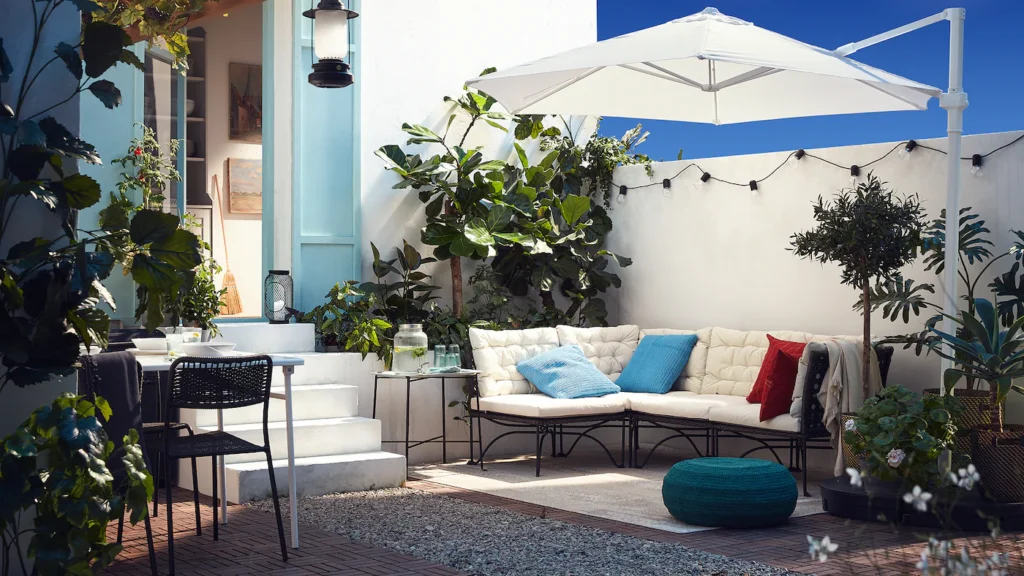Definition of an Outdoor Patio
An outdoor patio is an extension of your home’s living space, providing a relaxing and comfortable area for you to entertain guests, enjoy a meal, or simply relax. However, with continual exposure to the elements, it’s crucial to choose the right flooring material which can withstand various weather conditions, high traffic, and different temperatures.
The right flooring will not only add visual appeal to your patio but also increase its functionality, making it a more enjoyable space to spend time in. In this article, we will explore the best flooring options for outdoor patios, considering factors like weather conditions, cost, durability, and aesthetics.
Why Choose Flooring?
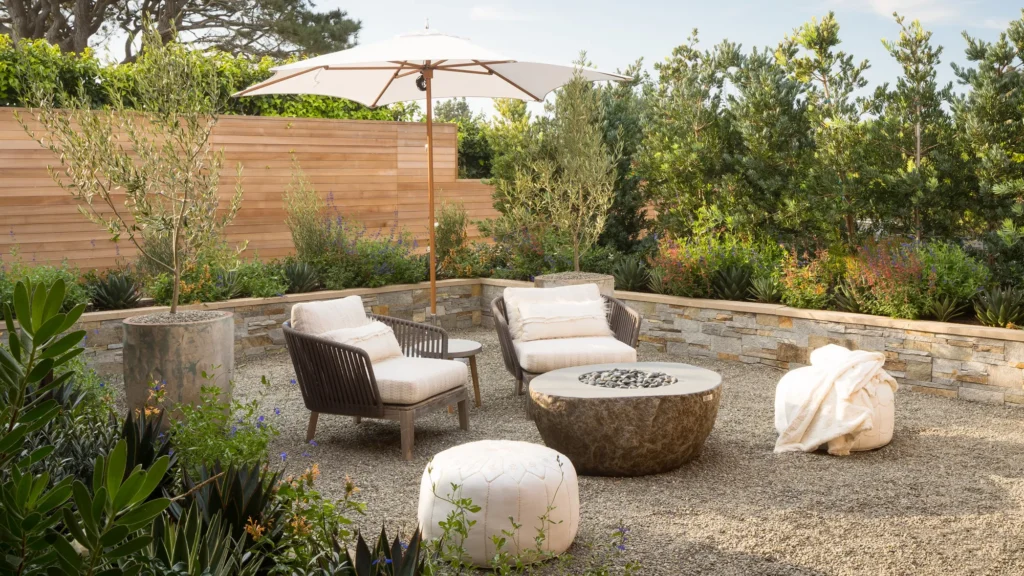
Choosing the right flooring for your outdoor patio may seem like a minor detail, but it plays a significant role in the overall look and functionality of your outdoor living space. There are numerous important reasons to give careful thought to the type of flooring you select.
One of the primary reasons to consider the importance of outdoor patio flooring is its impact on aesthetics. Quality flooring can add appeal and upgrade the general appearance of an outdoor space. A well-designed outdoor patio with the appropriate type of flooring will elevate the patio’s ambiance and impression. Choosing a high-quality material will add value to your property by harmonising the aesthetic features of your home and outdoor space.
Another crucial benefit of choosing proper patio flooring is maintenance. It is important to choose a flooring type that is easy to clean, maintain and keep in good condition. Selecting strong materials that withstand weather exposure ensures that you don’t have to replace it frequently. Investing in quality flooring reduces the maintenance cost and saves time.
Safety is also a vital consideration when choosing outdoor patio flooring. Safety should be a prime concern when selecting and installing your patio flooring as a poorly laid patio floor can lead to accidents and slips. A good quality flooring material offers better grip and stability, reducing the risk of falls and other injuries.
Numerous factors must be considered when choosing outdoor patio flooring. Weather condition is a significant factor to consider, particularly if you live in an area prone to extreme weather. Your chosen flooring type should remain unaffected by rain, snow, or extreme heat.
Durability is another essential factor to consider when choosing outdoor patio flooring. Opt for materials that can withstand heavy traffic and exposure to the elements. It is also essential to consider biodiversity and affordability. Look for options that fit into your budget plan without necessarily compromising on quality.
In conclusion, considering the importance of outdoor patio flooring is essential to enhance the functionality and aesthetic of your outdoor space. A well-chosen flooring type will not only upgrade the appearance of your outdoor space but also assure safety, reduce maintenance costs, and provide durability. Always consider factors like weather conditions, durability, safety, affordability, and maintenance when selecting the perfect flooring option for your outdoor patio.
Types of Flooring for Outdoor Patios
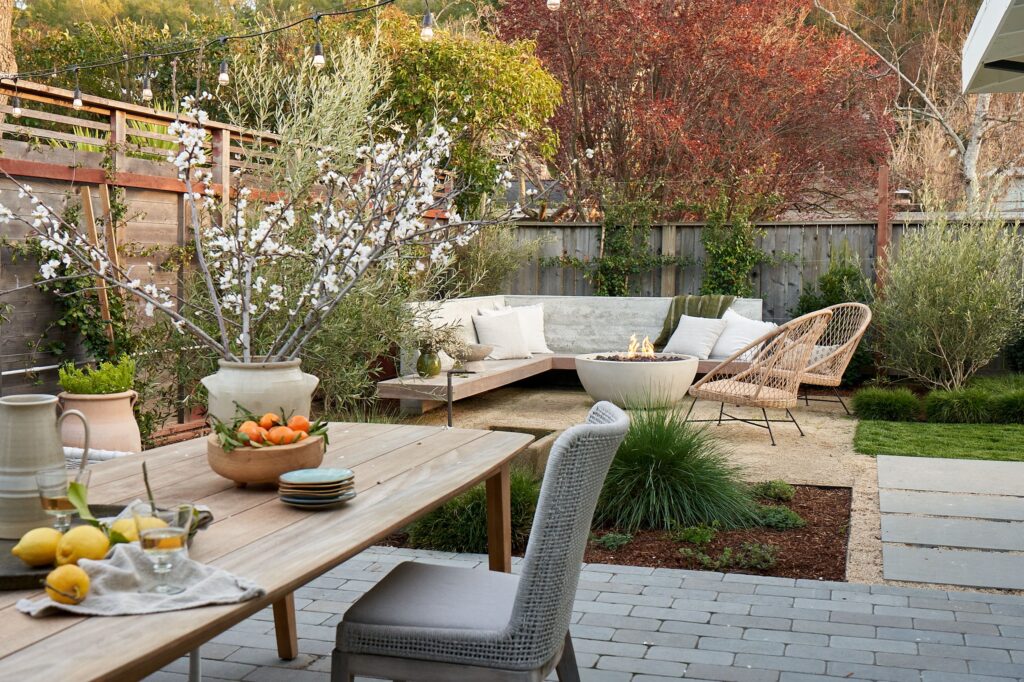
When it comes to outdoor patio flooring, there is no shortage of options to choose from. Each type of flooring offers unique benefits and appeal. Natural stone is renowned for its elegance and durability. Ceramic tiles are versatile, and their designs and colors can create an array of appealing patterns. For a low maintenance option, composite decking is a great choice, whereas outdoor carpets can bring warmth and texture.
For a classic and natural feel, choose natural wood, or go for the simplicity and strength of concrete floors. Natural grass adds a touch of greenery and freshness to an outdoor space, while concrete slabs offer a modern look. Finally, for safety and cushioning, rubber flooring is a great option.
Natural Stones
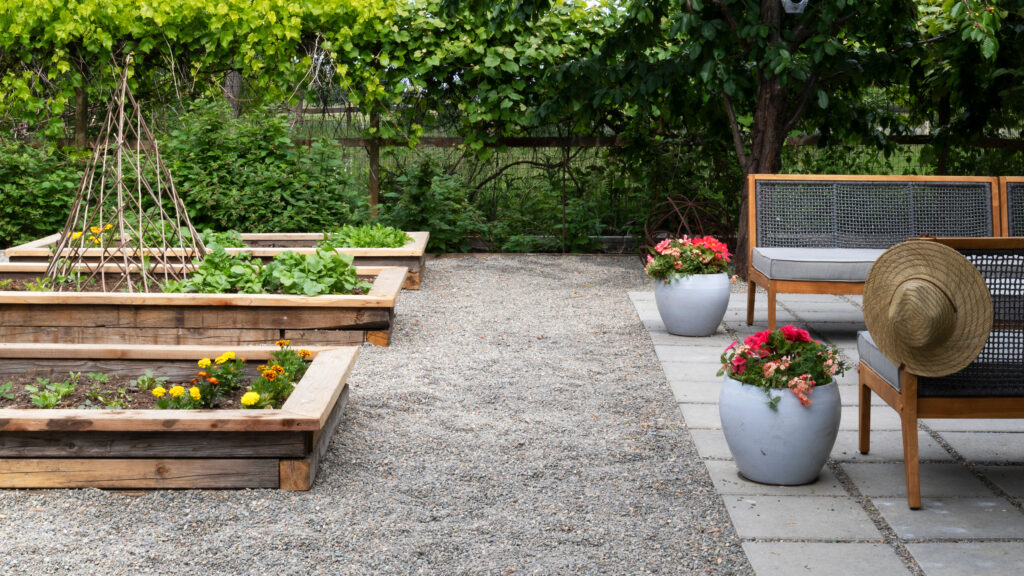
Natural stones are an excellent option for outdoor patio flooring. They are highly durable and can withstand the harsh weather conditions, making them an ideal choice for homes in any region. There are several types of natural stones that can be used for outdoor patios, each with its unique characteristics and beauty.
One popular natural stone for outdoor patio flooring is granite. This stone is highly durable and can sustain heavy foot traffic without any damage. It is resistant to stains, scratches, and extreme temperatures, which makes it a low-maintenance option for those who want to enjoy their patio without worrying about its upkeep. Granite also comes in various textures, such as polished, honed, or flamed, giving you a wide range of design options for your patio.
Another popular natural stone for outdoor patio flooring is slate. It has a unique texture that brings an old-world charm to any patio. It is available in various colors, from earthy tones to vivid blues and greens, providing you with plenty of design options. The rough texture of slate makes it slip-resistant, which is ideal for families with children or pets who love to run around the patio.
Sandstone is another type of natural stone that is perfect for outdoor patios. It has a natural, rustic look that complements any backyard design. Sandstone can be slippery when wet, so it is important to seek a textured variant of the stone. The porous nature of sandstone makes it susceptible to stains, so it is advisable to seal it regularly.
When it comes to natural stone patio designs, there are endless possibilities. You can create an elegant and contemporary patio using granite stones with a polished finish. Alternatively, you can opt for an old-world charm with slate stones and quirky patio designs. Sandstone, on the other hand, is perfect for creating a natural, rustic look for your outdoor space.
In conclusion, natural stones are a durable, low-maintenance option for outdoor patio flooring. Each type of natural stone has its unique characteristics and beauty, making it effortless to find the perfect one that suits your style and budget. The various design options available make natural stones an ideal choice for anyone looking to transform their outdoor space into an enticing oasis.
Ceramic Tiles
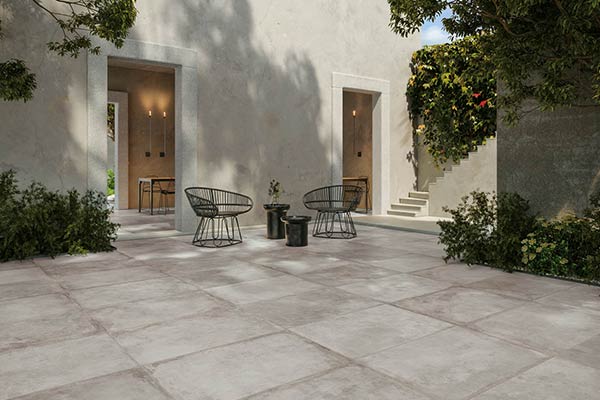
Ceramic tiles are a popular choice for outdoor patio flooring due to their durability and low-maintenance characteristics. They are water-resistant, making them ideal for outdoor use as they can withstand harsh weather conditions such as rain, snow, and heat without deteriorating or expanding. In addition, ceramic tiles are more affordable than natural stone options, making them a budget-friendly choice for homeowners.
Despite their advantages, ceramic tiles have some potential disadvantages that should be considered. Due to their composition, they do not perform well in frigid temperatures, which can cause them to crack or chip. Furthermore, ceramic tiles can become dangerous when wet as they become extremely slippery, increasing the risk of slipping and falling.
Designers often use ceramic tiles as an outdoor patio flooring option to create a cohesive look. They come in a variety of colors, shapes, and sizes, allowing for endless design possibilities. These tiles can be used in combination to create unique patterns, such as chevron or herringbone, to add visual interest to the space. They can also be paired with other materials, such as natural stone or wood, for a more natural look.
In conclusion, ceramic tiles are a versatile and affordable option for outdoor patio flooring. They are water-resistant and low-maintenance, but they do have some potential disadvantages such as their susceptibility to extreme temperatures and becoming slippery when wet. Nevertheless, designers use them creatively to achieve a cohesive look – from modern and sleek to rustic and natural. With proper installation and care, ceramic tiles can be an attractive and long-lasting addition to any outdoor patio.
Composite Decking
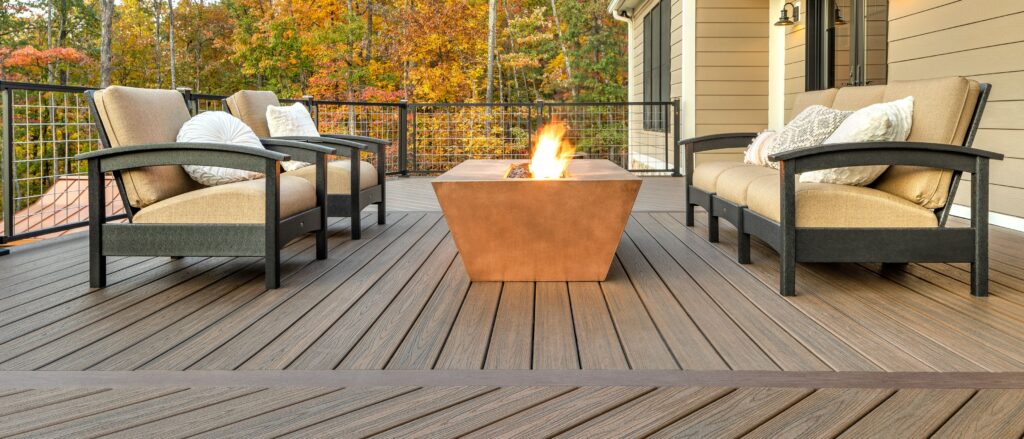
Composite decking is one of the best flooring options for an outdoor patio, offering the perfect combination of durability and style. It is made of a mixture of wood and plastic materials, giving it the look of natural wood without the hassle of maintenance that comes with traditional wood decking.
There are numerous benefits to composite wood decking. Firstly, it is highly resistant to fire, making it a safer choice compared to traditional wood decking. Additionally, composite decking is extremely versatile, offering a wide range of colors, styles, and finishes to choose from. It can be customized to match any outdoor design aesthetic, from contemporary to rustic.
Another major advantage of composite decking is its low maintenance. Unlike traditional wood decking, which requires frequent upkeep and is vulnerable to rotting, termites, and contracting or expanding in changing weather conditions, composite decking needs only occasional cleaning to stay in top shape. This makes it a popular choice for those who want to enjoy their outdoor patio without worrying about frequent upkeep.
For those who are looking for an easy way to cover up an existing concrete floor pad or balcony, composite deck tiles are a great option. They are durable, weather-resistant, and come in a range of trendy designs, including wood grain patterns. Installing composite deck tiles on top of an existing concrete slab is a quick and easy way to transform a plain outdoor space into a stylish patio or entertainment area.
In summary, composite decking is a fantastic choice for an outdoor patio, with its wood and plastic mixture providing a natural wood look without the high-maintenance needs of traditional wood decking. Its wide range of benefits, including fire resistance, versatility, and low maintenance requirements, make it a top choice for homeowners who want a durable and attractive outdoor flooring option. And the added option of composite deck tiles means that even an existing concrete floor can be easily transformed into a beautiful outdoor space.
Outdoor Carpets

Outdoor carpets have become a popular flooring option for those looking to add a cozy touch to their outdoor patio. With a soft and inviting texture, outdoor carpets provide a comfortable surface for outdoor activities like reading, enjoying meals, or lounging. Outdoor carpets also come in a variety of colors, patterns, and textures, making them a stylish choice for those who want to enhance their outdoor design aesthetic. However, like any flooring material, outdoor carpets have their pros and cons.
One of the primary advantages of outdoor carpeting is its affordability. Compared to other outdoor flooring options like natural stones or composite decking, outdoor carpets are the least expensive option. They are also easy to install over existing surfaces like concrete, making it an ideal solution for a DIY project.
However, outdoor carpets are not the best option for damp climates. They can trap moisture and create a breeding ground for mold and mildew. Moreover, outdoor carpets are best-suited for dry and sunny climates. In areas of high rainfall, they may require extra attention to avoid damage or deterioration.
There are primarily two types of outdoor carpets available in the market: natural fiber outdoor carpets and polypropylene outdoor carpets. Natural fiber outdoor carpets like sisal or jute have a natural look and feel, but they are less durable and easy to stain. Polypropylene outdoor carpets, on the other hand, are more durable and resistant to moisture and stains than natural fibers but have a synthetic feel.
In terms of safety, outdoor carpets can provide good traction. Outdoor carpets have a non-slip surface that can help prevent falls and injuries, making them a great option for families with small children or elderly people.
When considering outdoor carpeting as an option, it is important to understand the weather conditions in your area. If you live in a damp climate, it may be best to look for another flooring solution. But, if you reside in a dry climate and are on a budget, outdoor carpets can provide an affordable yet stylish option for your outdoor patio.
Natural Wood
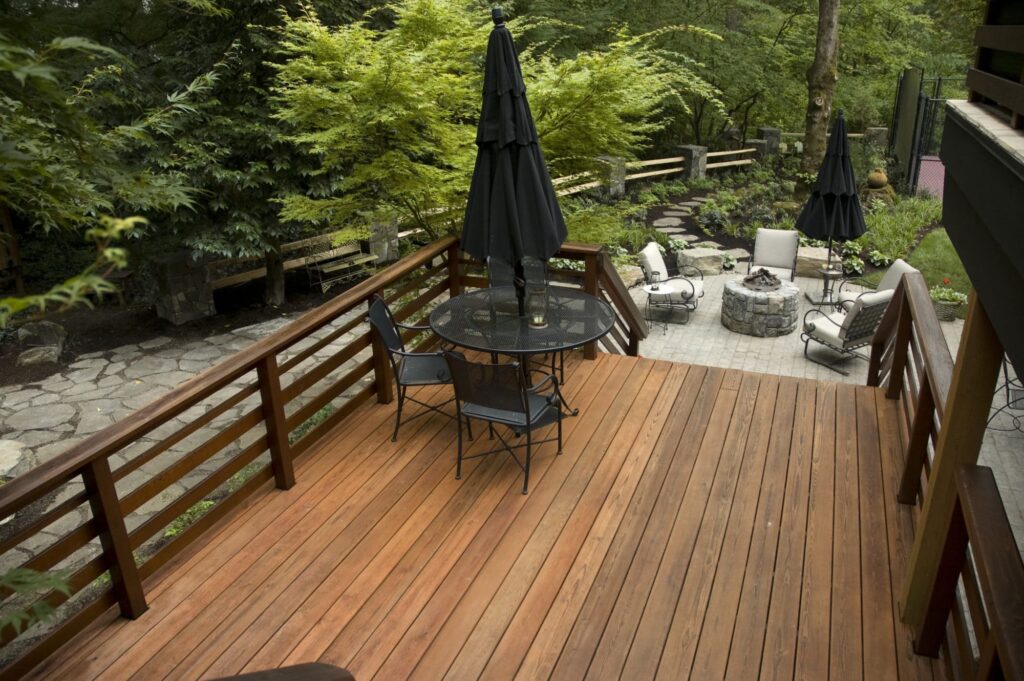
Natural wood is a popular choice for outdoor patio flooring due to its unique features and benefits. Its timeless and classic appearance provides warmth and a cozy, inviting atmosphere in any outdoor space. Natural wood is also an eco-friendly option as it is a renewable resource, making it an excellent choice for those looking to minimize their environmental footprint.
There are various types of wood available for use in outdoor flooring, with cedar, redwood, and pressure-treated pine being some of the most popular options. Cedar and redwood are naturally resistant to rot, insects, and decay due to the presence of natural oils in the wood, making them highly durable and low maintenance. On the other hand, pressure-treated pine has been treated with chemicals to increase its resistance to natural elements, which can result in a higher level of durability and longevity compared to untreated pine.
While cedar and redwood have a higher initial cost than pressure-treated pine, they are more resistant to natural elements and require less maintenance over time, making them more cost-effective in the long run. However, it’s important to note that natural wood does require proper maintenance, such as regular sealing and staining, to increase its longevity and protect it against wear and tear from sun exposure, moisture, and foot traffic.
When choosing natural wood for outdoor patio flooring, it’s crucial to select high-quality wood to ensure its longevity and minimize the need for frequent replacement. Additionally, it’s important to choose a type of wood that is suitable for the climate and weather conditions in your area to ensure that it can withstand the natural elements.
Overall, natural wood is an excellent choice for outdoor patio flooring due to its timeless appearance, warm and inviting atmosphere, and natural resistance to rot and decay. Cedar, redwood, and pressure-treated pine are popular options, each with their own unique set of pros and cons. With proper care and maintenance, natural wood can provide a beautiful and durable outdoor flooring option for many years to come.
Concrete Floors
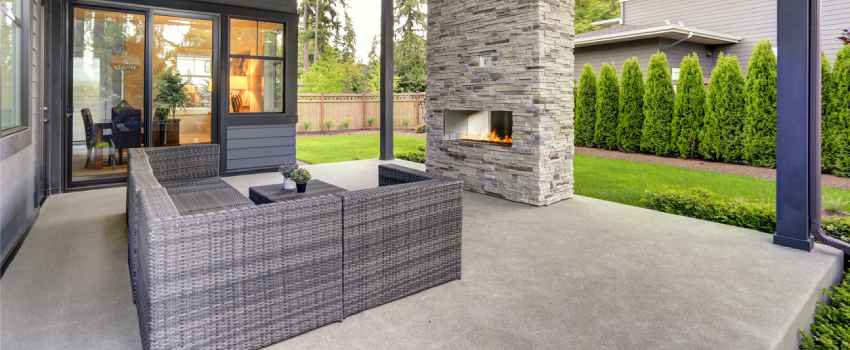
Concrete flooring has become a popular choice for outdoor patio areas due to its numerous benefits. One of the main advantages of concrete flooring is its durability, as concrete can withstand heavy foot traffic and natural elements such as rain, sun, and wind. It is also an affordable option compared to other outdoor patio flooring materials, making it accessible for those on a budget.
When it comes to concrete flooring, there are various types available to choose from. Stamped concrete is a popular option, which involves creating a patterned surface similar to natural materials, such as stone and wood. Painted concrete flooring is another option, allowing for a range of colors and designs to be applied to the surface. This can create a unique and personalized outdoor space.
In terms of design options, there are many choices available for concrete flooring. Cement-effect models can create a modern, industrial look for an outdoor patio, while graphic designs can add a touch of art and creativity to the space. There are also diverse color options available, which can give a fresh and modern look to any outdoor area.
Choosing the right paint or stain for concrete surfaces can be crucial to maintain a polished look for a prolonged period of time. It’s important to select a paint or stain that is suitable for outdoor use and that can withstand natural elements. It’s also important to apply a sealer to concrete floors to protect them against wear and tear and to ensure longevity.
In summary, concrete flooring is a durable and affordable option for outdoor patios with various types available, such as stamped and painted concrete flooring. Design options include cement and concrete-effect models with graphic designs and diverse color choices. Choosing the right paint or stain and applying a sealer is important for maintaining a polished look.
Natural Grass
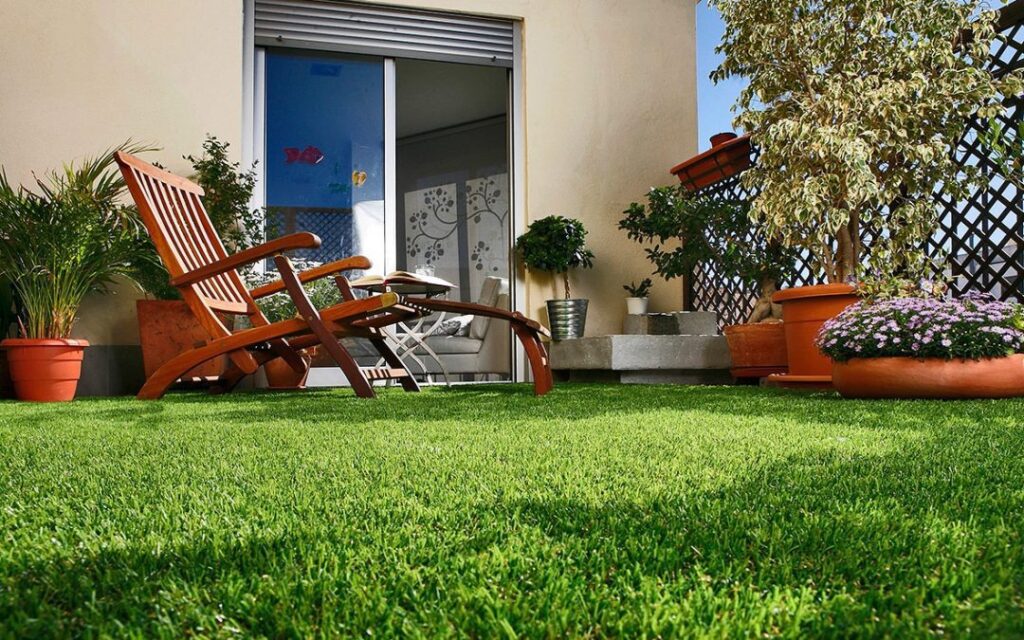
Natural grass is an option for outdoor patio flooring, providing a lush and natural aesthetic to any outdoor space. However, not everyone may prefer natural grass due to the maintenance it requires.
To grow properly, natural grass needs to be planted and fertilized in soil that has the right weather conditions, sunlight, and water. It requires proper care and attention to maintain healthy growth, such as regular watering, mowing, and fertilization.
Despite the maintenance required, there are several advantages to having natural grass as an outdoor patio flooring option. One of the main benefits is that natural grass is easy on your feet, providing a comfortable surface to walk or sit on. In addition, grass absorbs heat, which can help keep your outdoor space cool during warmer temperatures.
Natural grass is also a great area for kids and pets to play on, creating an ideal outdoor space for families to enjoy. While the maintenance aspect may be a downside for some, the lush and natural aesthetic may outweigh the extra upkeep required.
Concrete Slabs
Concrete slabs are a popular option for outdoor patio flooring due to their durability and affordability. However, there are both benefits and drawbacks to using them.
One significant benefit of using concrete slabs is their durability. Concrete is hard and long-lasting, making it resistant to damage caused by severe weather conditions, heavy foot traffic, and outdoor furniture. Concrete slabs require very little maintenance compared to other flooring options, making them an ideal choice for homeowners who prefer low-maintenance outdoor spaces.
On the downside, creating a plain concrete slab can be labor-intensive and time-consuming. The process involves forming the slab, which requires digging out the area and bordering it with wood or metal forms. After that, the pre-mixed concrete is poured into the form and allowed to set.
The tools required for creating a plain concrete slab include a shovel, rake, trowel, wheelbarrow, concrete mix, and water. Additionally, safety equipment, such as gloves, safety glasses, and a mask, should be worn when working with concrete.
However, homeowners can jazz up their plain concrete slab by adding color, texture, or pattern. One option is staining the concrete to give it a more polished look. Staining can be done either before the concrete is poured or after it has cured. Another option is stamping concrete to mimic the look of brick, stone, or tile. This option is perfect for homeowners who prefer a more decorative appearance for their outdoor patio.
Despite being hard and durable, plain concrete slabs may not be everyone’s preferred choice for outdoor patio flooring. However, the available options for enhancing the look of a plain concrete slab make it a versatile and affordable choice for homeowners who want an easy and straightforward outdoor flooring option.
Rubber Flooring
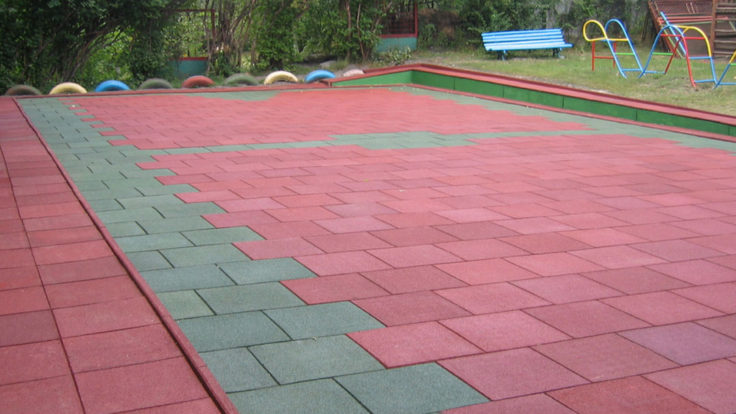
Rubber flooring is a unique and innovative option to consider for outdoor patios. It offers several benefits and drawbacks to homeowners, making it a popular choice in certain situations.
One of the most significant benefits of using outdoor rubber flooring is its slip-resistant nature. Rubber has excellent traction, meaning it is less likely to cause slips and falls, an important consideration for homeowners who want to ensure the safety of their patio. Additionally, rubber is incredibly durable, making it long-lasting against harsh weather conditions, foot traffic, and outdoor furniture.
However, it is essential to keep aesthetic considerations in mind when choosing rubber flooring. It may not be the most visually appealing option for a patio, especially for homeowners looking for a more natural or rustic look. Rubber flooring typically comes in solid colors and is not available in a wide variety of patterns or textures, narrowing the options for visual customization.
Despite limited visual appeal, outdoor rubber flooring offers homeowners an affordable, low-maintenance outdoor flooring option. It is easy to install and requires little maintenance over time, another perk for homeowners who want to minimize upkeep for their outdoor space.
In summary, rubber flooring is a slip-resistant and durable option for outdoor patios, but its aesthetic considerations may not work for every homeowner’s preferences. For those looking for a reliable and low-maintenance choice, outdoor rubber flooring may be the perfect solution.
Factors to Consider When Choosing the Best Flooring for an Outdoor Patio
When it comes to choosing outdoor patio flooring options, homeowners have a wide variety of materials to select from. Two critical factors to consider are weather conditions and budget constraints. Since outdoor patios are exposed to rain, sun, and other elements, it’s essential to select a flooring material that can withstand these weather conditions. At the same time, homeowners must balance their budget with their desired level of flooring durability, deciding whether to go for more affordable or more durable options.
Weather Conditions
Choosing the right outdoor patio flooring material based on weather conditions is crucial to ensure that your investment lasts for many years. Extreme weather conditions can take a toll on certain materials, causing them to crack, fade, or damage over time. This is why it’s crucial to keep weather considerations at the forefront when selecting a flooring option.
Outdoor porcelain flooring is a popular choice for patios, but it may not be the best option for areas with severe temperature fluctuations. Porcelain can crack under extreme cold weather, making natural materials like stone a better choice for extremely low temperatures.
Outdoor tiles are another excellent option for outdoor patios. They are durable, low-maintenance, and come in many different materials. Terracotta tiles are an affordable and hardy choice, while ceramic tiles are easy to install and remain cool in warmer climates. Natural stone tiles are also an excellent option if you want to add an elegant touch to your patio area.
Slip resistance is another important factor to consider when choosing an outdoor patio flooring material. In wet conditions, such as around the pool area or in high-traffic zones, slip-resistant flooring is a must. Look for materials that have a textured finish or a rough surface to provide better grip and reduce the risk of falls and accidents.
In conclusion, choosing the right outdoor patio flooring material based on weather conditions is a vital factor for the longevity of your investment. Natural materials like stone may be more suitable for extremely low temperatures, while outdoor tiles like terracotta and ceramic are a popular and durable choice. Slip-resistant flooring is also essential for wet conditions, especially around the pool area and high-traffic zones.

